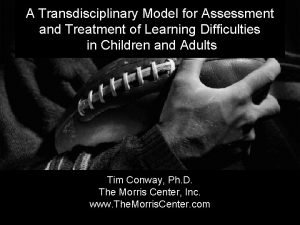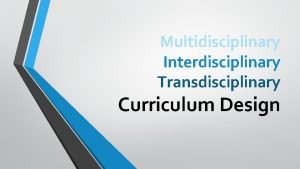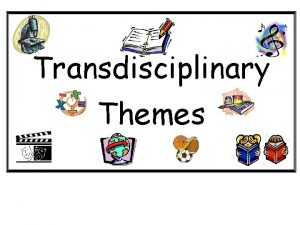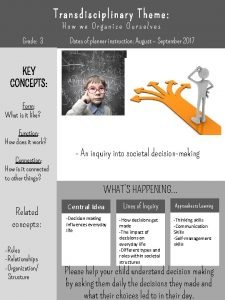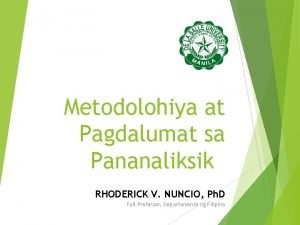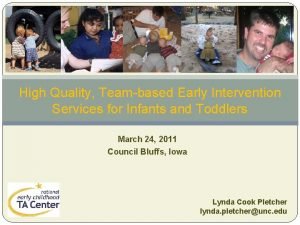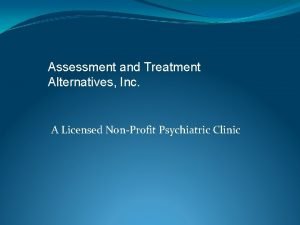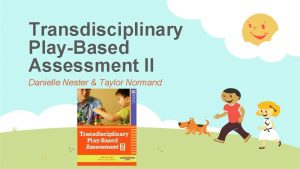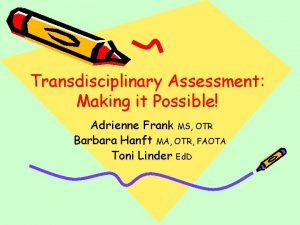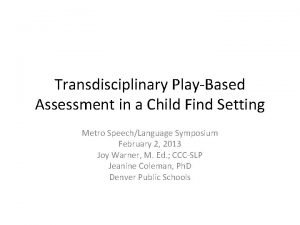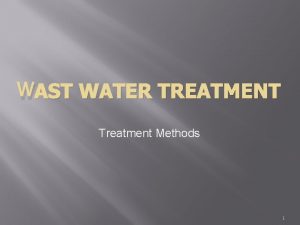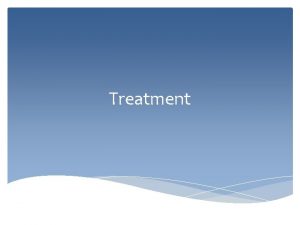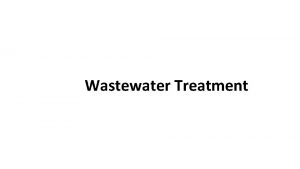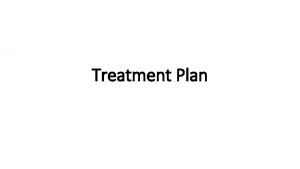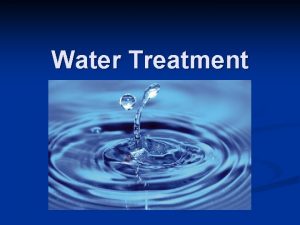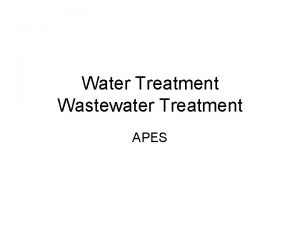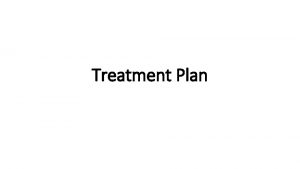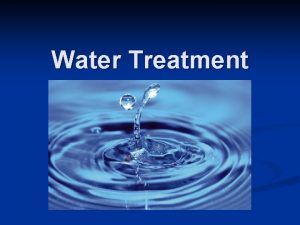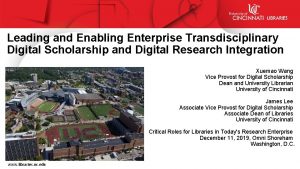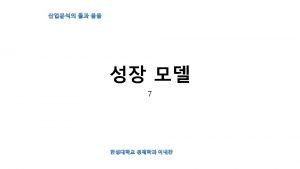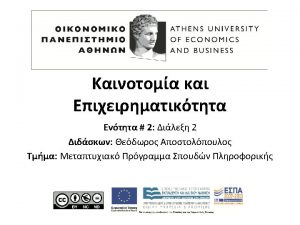A Transdisciplinary Model for Assessment and Treatment of




















- Slides: 20

A Transdisciplinary Model for Assessment and Treatment of Learning Difficulties in Children and Adults Tim Conway, Ph. D. The Morris Center, Inc. www. The. Morris. Center. com

Transdisciplinary • two or more disciplines pool their approaches/knowledge and modify them, so that by working together they are better able to improve/treat the “problem” or “weak” skills.

Transdisciplinary Assessment & Treatment Program for Learning Disabilities Overview of Services • Intake/Screening Appointment • Phase I Assessment • Phase II Assessment • Treatment • Post-treatment Assessment • Follow-up/Generalization 1933

Learning Disabilities - Reading • • • Dys = difficulty & Lexia = words Poor skills in Reading Neurological in origin Lifelong, but environment may alter course Core deficit in Phonological Component of Language • Accompanying Challenges (~50%) – ADHD – Sensorimotor – Behavior problems

Transdisciplinary Team • Disciplines on the team – Pediatrician/Psychiatrist – Nursing/Nurse Practitioner – Psychology/Neuropsychology – Occupational Therapy – Speech-Language Pathology – Teacher/Special Education

Transdisciplinary Assessment • Intake/Screening Appointment with Director – Collection of records – Identify presenting concern(s) – Provide scope and sequence of assessment and treatment program, timeline of program, associated costs, … – Provide research/educational data, identify additional community resources, etc … – Determine fit for The Morris Center’s services and client’s needs 1960

Transdisciplinary Team Assessment Two Phase Assessment Phase I: Broad Neurodevelopmental Evaluation & Medical History Phase II: Assessment of Specific Abilities to Identify an Individual Profile of Strengths & Weaknesses (for diagnostic and treatment planning purposes)

Transdisciplinary Team Assessment • Phase I Evaluation (broad screening) – Neurodevelopmental evaluation • Medical and Developmental History & Exam • Screening of all brain systems including neuromotor, perception, learning, attention, speech, language, memory, motor planning and cognition. • Nutrition, sleep, behavior, allergies, medical… – Psychological evaluation • Diagnostic interview – psychosocial, educational, behavior, & family history.

Transdisciplinary Team Assessment • Phase I Assessment Team members: – Nurse Practitioner or Developmental. Behavioral Pediatrician – Clinical Psychologist or Pediatric Psychiatrist – Director of The Morris Center

Transdisciplinary Team Assessment • Phase II – in-depth assessment to identify an individual’s specific areas of strength and weakness that may contribute to presenting concerns or difficulties: – – – – Attention/Intention Intelligence/Cognition Oral Language Memory Sensorimotor Written Language Mathematics Behavioral Observations

Transdisciplinary Team Assessment • Phase II Team Members – – – – Clinical Psychology Neuropsychology Occupational Therapy Speech Language Pathology Educational Specialist Nursing Psychometrist

Transdisciplinary Treatment Program • Key treatment features are based on neuroscience and behavioral treatment research findings – Intensity (# of hours per day) – Frequency (# of days per week) – Specificity (clarity of treatment program) • Ongoing data collection of program effects for program self-evaluation • Selective post-treatment assessment with standardized tests to document treatment gains

Transdisciplinary Treatment Program Treatment targets within an Transdisciplinary model: • Speech-Language Therapy – Targets improving foundational language skills that may cause the learning difficulty, e. g. phonological processing/decoding • Occupational Therapy – Targets sensory and motor skills that may contribute to learning difficulties, e. g. sensory defensiveness, visual processing/perception, etc. • Psychiatric/Medical – Medication and behavioral management of attention, mood or behavior disorders. • Psychological Treatment – Client • e. g. developing adaptive coping skills for academic and life stressors – Parent • e. g. better behavior management, conflict resolution training, etc… – Client & Parent/Spouse (separately or combined) • Developing adaptive family or marital functioning, relative to learning difficulties.

Treatment - Case Study • • High school student History of dyslexia Years of school-based academic intervention Years of reading tutoring – commercial centers, by private 1: 1 tutors… – a family member was an ESE Reading Specialist • A first-team athlete • Weak skills in: – – – reading (>5 years below grade), writing & spelling comprehension auditory and visual memory visual-spatial attention

Treatment - Case study • Transdisciplinary Phase I & II assessments identified weaknesses in: – Language • poor phonological processing, reading, spelling and comprehension – Occupational Therapy • sensory integration deficits including poor praxis, vestibular, visual vigilance, visual tracking, and visual processing – Medical • poor attention, as exhibited by difficulty maintaining attention to relevant visual and auditory stimuli

Transdisciplinary Treatment Program • Individualized, Transdisciplinary treatment – Speech-Language Therapy – Occupational Therapy – Clinical Psychology/Counseling • Intensive, Frequent and Explicit Treatment – 22 -25 hours of language treatment per week • 5 days/week for 4 -5 hours/day – 1 hour of counseling per week – 1 hour of parent education per week – 5 hours of occupational therapy per week • 12 weeks of 1: 1 Transdisciplinary treatment – (duration of treatment is client dependent)

Documented Treatment Results • Selective re-administration of pre-treatment standardized, nationally normed-tests for measurement of post-treatment gains. • Graphical representation shows pre-treatment scores as blue stars and post-treatment scores as green stars • Green arrows indicating areas of significant gain or improvement.

pre-treatment skills post-treatment skills

Transdisciplinary Assessment and Treatment Goals • Identify and then improve weak skills to develop new strengths in: – – Language Sensorimotor Cognition/attention Behavior • Develop independent functioning in language, sensorymotor, behavior & achievement, relative to an individual’s true potential. • Provide essential “tools” for success in academic, occupational and interpersonal domains of life.

Thank You www. The. Morris. Center. com
 Transdisciplinary model
Transdisciplinary model What is interdisciplinary
What is interdisciplinary Transdisciplinary theme who we are
Transdisciplinary theme who we are Transdisciplinary team approach
Transdisciplinary team approach How we organize ourselves grade 4
How we organize ourselves grade 4 Metodolohiya kahulugan tagalog
Metodolohiya kahulugan tagalog Interdisciplinary multidisciplinary transdisciplinary
Interdisciplinary multidisciplinary transdisciplinary Assessment and treatment alternatives
Assessment and treatment alternatives Fspos
Fspos Typiska novell drag
Typiska novell drag Nationell inriktning för artificiell intelligens
Nationell inriktning för artificiell intelligens Returpilarna
Returpilarna Shingelfrisyren
Shingelfrisyren En lathund för arbete med kontinuitetshantering
En lathund för arbete med kontinuitetshantering Särskild löneskatt för pensionskostnader
Särskild löneskatt för pensionskostnader Tidbok för yrkesförare
Tidbok för yrkesförare A gastrica
A gastrica Vad är densitet
Vad är densitet Datorkunskap för nybörjare
Datorkunskap för nybörjare Stig kerman
Stig kerman Debattinlägg mall
Debattinlägg mall
